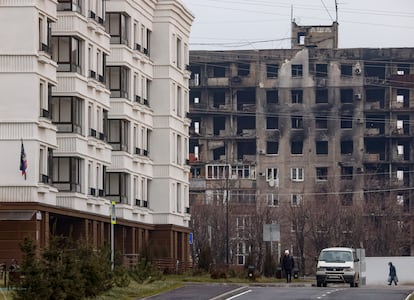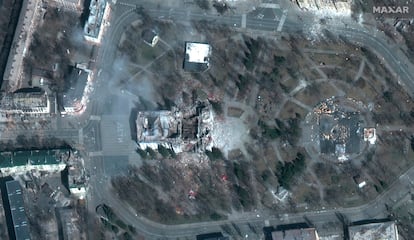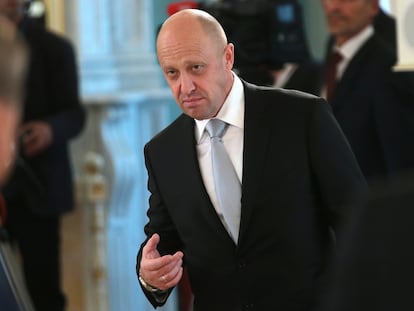After months of bombing, Russia starts rebuilding Mariupol
The reconstruction plan, due for completion in 2035, aims to support the narrative that Moscow has saved the Russian-speaking population from Ukrainian discrimination
For 80 days between February and May, the Russian army besieged the city of Mariupol. Artillery and shelling leveled most of the buildings in this coastal city on the Azov Sea. Mariupol is a key hub linking the Crimea peninsula, which Russia illegally annexed in 2014, with eastern Ukraine’s Donetsk and Luhansk regions, a declared target of Putin’s invasion. In September 2022, Russia declared it was annexing the occupied territories, including Mariupol.
Ukrainian authorities say that during the Russian siege, at least 25,000 residents of this city died out of a pre-war population of 430,000. The United Nations has confirmed the deaths of about 1,350 residents, but admitted this is a partial count and that there are “probably thousands more dead.” Tens of thousands more fled or were sent out of Ukraine. About 90% of the buildings were damaged or razed by the attacks.
Now that the city is under its control, Russia has begun a reconstruction plan. In just six months, the Kremlin has built new homes in this destroyed city: a dozen apartment buildings with room for about 2,500 people now stand on Kuprina Street, southwest of the city. The following images, captured by the European Space Agency’s Sentinel-2 satellite, show how the land changes from a vacant lot in June to a residential complex in December.
The construction of new homes is part of Moscow’s master plan for rebuilding Mariupol, first revealed by Russian website The Village in August. The document, signed by the Unified Institute for Land Planning of the Russian Federation, is planning the construction of 8,750,000 square meters of housing by 2035, including some prefabricated units. Crews have also started to demolish the dilapidated buildings.
The housing complexes, built by the Russian Ministry of Defense, have a playground, parking and an area for sports. The more than 1,000 units have been delivered free of charge to the population. In front of these blocks there stands a veritable cemetery of shelled buildings destroyed by bombs, projectiles and shrapnel. In the first month of the siege alone, Russian shelling and street-to-street fighting caused the destruction of at least 365 buildings, according to an analysis by UNOSAT, the United Nations satellite center. In that period of time, according to the same source, three hospitals and seven schools, among other places, were bombed.

For Luis Velasco-Martínez, a professor of contemporary history at the University of Vigo in Spain, what Russia is trying to do with this reconstruction effort is to “legitimize its actions after it initiated the invasion, but also to legitimize the local and regional governments that have been set up in the region.” Russian president Vladimir Putin justified the invasion out of the “need to denazify” Ukraine and bring it back under Moscow’s wing. “He has focused his efforts on disseminating the narrative that the eastern regions of Ukraine are ethnically and linguistically Russian and its population is mostly pro-Russian or directly Russian, but now he must prove it and try to ensure that the inhabitants of those regions uphold that narrative too,” he explains.
Moscow’s reconstruction plan will grant preference to housing, reconstructing the old town, developing the downtown area and the park, creating an extensive transportation infrastructure, and reconverting the Azovstal steelworks plant – where Ukrainian forces made their final stand – into an industrial and technology park.
Rebuilding the historic city center
On March 16, missiles hit Mariupol’s Drama Theater. The attack caused hundreds of deaths and injuries. Amnesty International defines it as a war crime, accusing Russia of knowing that civilians were sheltering there. That same theater is now covered with a screen, and Russian authorities, who have been in control of the city since May, are rebuilding the demolished building, along with the square in front of it.


Almost all the buildings in the old town were damaged by the shelling, according to data from Masae Analytics, a geospatial analysis consultancy. Now the Russian government is proposing to rebuild several of the iconic buildings there as well.
“Let’s not forget that Russia annexed the occupied territories in September 2022, Mariupol included,” notes Salvador Sánchez Tapia, a professor of conflict analysis and international security at the University of Navarre. This means that to Russia, this city is an integral part of its own territory. Located just 40 kilometers from the Russian border, Mariupol is a port on the Azov Sea that is crucial to Russian supply lines.
In addition, the reconstruction itself has a high symbolic value, even more so when the city was devastated and emptied out. Around 440,000 people resided there before the invasion, and it is estimated that only a quarter of its population remained after the capture of the city. Tens of thousands of people died, while others fled or were sent out of Ukraine.
Why Mariupol?
In Mariupol, Russian is the mother tongue of about 90% of the inhabitants, so it is a place where it makes sense to start to show the Russian-speaking population the point of the invasion, argues Salvador Sánchez: “The city was devastated, and if Russia wants to present itself as a liberator, the first thing it must do is return the city back to ‘normal’.
The reconstruction plan, due to take place between now and 2035, aims to reflect the narrative that Russia has saved the Russian-speaking population from Ukrainian discrimination and perpetuate its legacy in Mariupol.
An Associated Press investigation based on videos and testimonies on the ground suggests that this reconstruction is a pretext to hide the war crimes that Russia committed eight months earlier by attacking a theater in full knowledge that hundreds of civilians were sheltering inside.
Sign up for our weekly newsletter to get more English-language news coverage from EL PAÍS USA Edition

